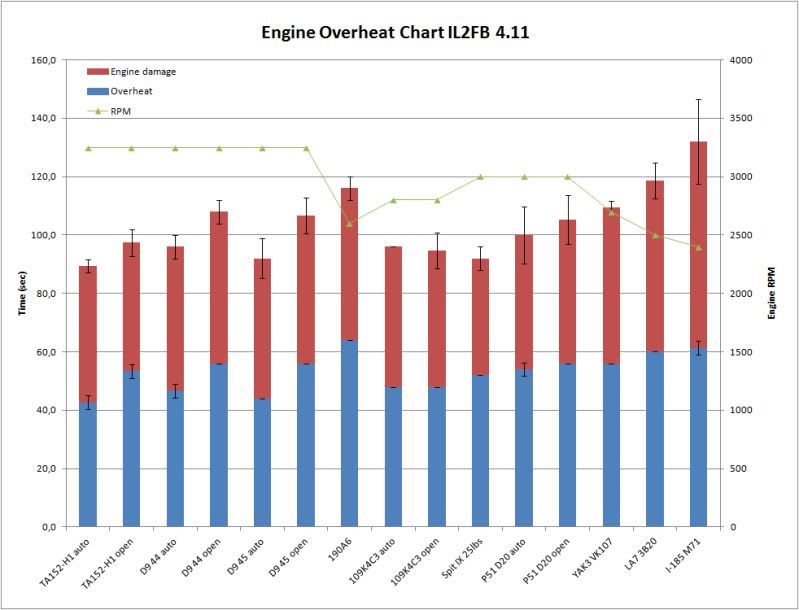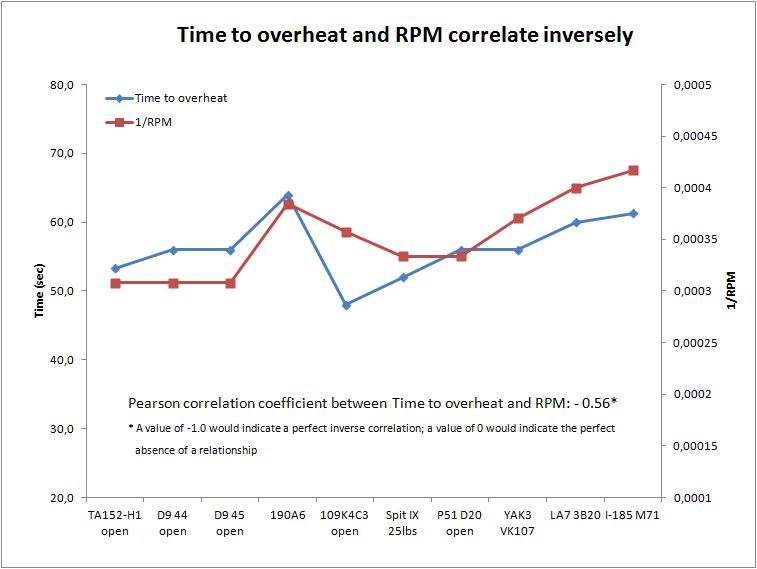
 |
|
|||||||
| IL-2 Sturmovik The famous combat flight simulator. |
|
|
Thread Tools | Display Modes |
|
#1
|
|||
|
|||
|
Hi,
some folks are seriously concerned that some planes might overheat too much in 4.11, while others might overheat much less. Specifically, Whistlinggdeath feels that the TA152H, P51 and FW190D9 45 overheat too much, especially during zoomclimbs, while the I-185 M71 and SpitIX 25lbs show almost no overheat. Us JG27 folks have tested 4.11 extensively in internal fullreal matches and found no reason to worry. However, dogfights are not objective, specific tests. To get some reproducible numbers, i've put several planes to the ultimate overheat test on the crimea map: with the plane grounded, chocks in, pp 100% or auto (where available) i ran the engine to absolute max power, measuring the time until the overheat message appeared and until engine damage occured. Full power was applied immediately after engine ignition. I repeated the test at least 3 times per plane, and calculated average values as well as standard deviation (displayed as error bars). Unless stated otherwise, radiators were open. I've also plotted engine rpm at max settings. This test provides an estimate on how fast a plane will overheat when reaching very low speeds at full power, as happens at the top of some zoomclimbs. For a given plane, the time to overheat is highly reproducible (small error bars, see figure below). The error bars get a little bigger for the time to engine damage, where random effects come into play. As you see, all planes overheat pretty fast under the given circumstances, and the differences between planes are minor. In my view, there's no reason to worry. Contradictory to Whistlinggdeath's description, SpitIX 25lbs and P51 D20 overheat at almost exactly the same time. The TA152 H1 overheats slightly faster than the Spit with radiators on auto. With manually opened radiators, however, the TA overheats slower than the Spit! This trend is also seen for the FW190D9 models, but not for the 109K4 and P51. In summary, the automatic radiator opens a little late on the TA and D9. The most overheat-resistant planes in this test are the FW190A6 and the I-185 M71.  It seems that rpm values and overheat times correlate inversely: planes with low rpm (I-185 and FW190) are slow to overheat, while planes with high rpm (TA152) seem to overheat faster. To test this hypothesis i plotted the reciprocal of RPM values (1/RPM) against the average time to overheat (open radiators, see figure below). As expected, both curves are very similar, and this impression is confirmed by the calculated Pearson correlation coefficient between RPM and time to overheat. The correlation value of -0.56 indicates a fairly strong inverse correlation between engine rpm and time to overheat. In other words: high rpm results in faster overheat, across the planeset.  ***EDIT*** I've just tested the TA152, FW190A6, SpitIX 25lbs, LA7 3xB20, F4U-1D and I-185 M71 inflight on the same map: max performance takeoff and climb at a constant 260kph IAS. I used manually open rads on the TA, FW190 and I-185, auto rads for the spit. Here are the times to overheat at 260kph IAS: Plane_________time to overheat____notes__________________ TA152-H1........3'24''......................oil temp near upper limit SpitIX 25lbs.....2'56''......................oil at 80°C, glycol at 110°C FW190A6.........3'48''......................oil at less than 80°C F4U-1D............3'52''.....................oil temp 80°C, cylinder head 200°C at overheat message LA7 3xB20........3'48''......................oil temp is above 100°C from 1'56''on; cylinder head temp above 200°C at overheat message I-185 M71........5'08''.....................oil temp is above 100°C from 2'08'' on; cylinder head temp above 200°C at overheat message Something seems to be wrong with the I-185. For one, it overheats on the ground just like any other plane, but much later in the air. While most other planes overheat when the oil has 80°C, the I-185's oil temps hits the end of the dial (125°C) before the overheat occurs. At that stage, the cylinder head has well above 200°C. This behavior is very different from that of other radial engine fighters in the test (F4U, FW190A). The LA7 also shows that oil temp increase, but the overheat message comes earlier, at almost the same time with the FW190A and F4U. Maybe someone from TD could explain why the I-185 is different? ***EDIT END*** Cheers Last edited by JG27_PapaFly; 01-26-2012 at 02:36 PM. |
|
|